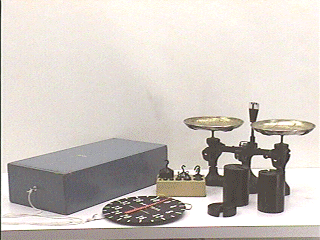

PURPOSE: To show that the friction force depends linearly on the normal component of the applied force.
DESCRIPTION: 1. Put 5-kg mass on left pan of balance and the blue block on the right pan. Add to the right pan 1 kg plus additional masses from the weight set to achieve balance. 2. Place block on lecture table with the additional right-pan weights on top of it. (Together they have a mass of 5 kg.) 3. Determine the force of friction by pulling the box with its weights across the lecture table using twine and the spring scale. Place additional 5 kg mass on block and repeat. Repeat with block on edge. Typically about 13 Newtons is required to pull the 5 kg combination. This gives a coefficient of friction mu=13/(5X9.8)=0.26, which is roughly what is expected for wood on wood. The difference between static an sliding friction is readily visible.
SUGGESTIONS: This demonstration is bigger, and therefore may be more accurate and easier to use than some of the smaller versions.
REFERENCES: PIRA 1K20.00.
EQUIPMENT: Large blue block with eye and twine, 40 Newton spring scale, one 1 kg mass, two 5 kg masses, weight set, pan balance.
SETUP TIME: 10 minutes
 |  |  |  |  |